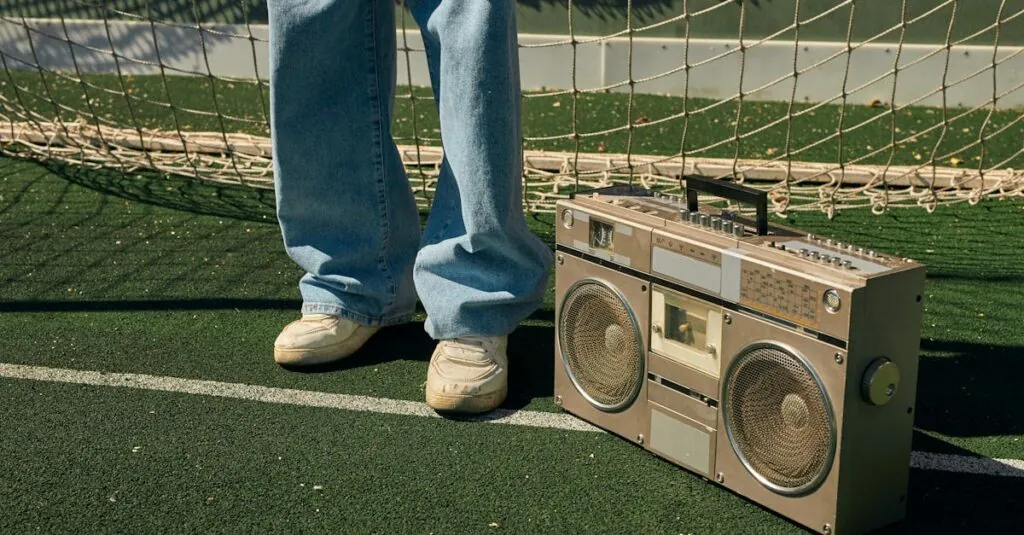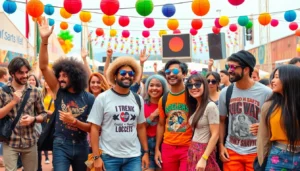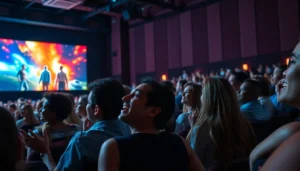Table of Contents
ToggleIn a world obsessed with the latest tech and trends, it seems nostalgia is making a stylish comeback. Retro revival trends are sweeping through fashion, design, and even music, proving that sometimes the best way to move forward is to look back. Who knew that flared jeans and cassette tapes would become the hottest items on the block?
Overview of Retro Revival Trends
Retro revival trends reflect a cultural longing for nostalgia across various sectors. Fashion sees a comeback of iconic styles from the 70s, 80s, and 90s, with flared jeans and crop tops gaining popularity. In music, vinyl records and cassette tapes are resurging, appealing to collectors and new listeners alike.
Design embraces vintage aesthetics, incorporating bold colors, geometric patterns, and retro furniture into modern spaces. Home decor trends often feature mid-century pieces that blend functionality with nostalgic charm.
Technology also plays a role, as vintage-inspired gadgets, like instant film cameras, become favorites among younger generations. The intersection of retro styles and modern innovation creates a unique cultural blend that resonates with diverse demographics.
Events celebrating retro themes, like throwback parties and retro gaming tournaments, showcase the enduring appeal of past decades. Community interest groups around music and fashion continue to grow, fostering local scenes that emphasize vintage appreciation.
By embracing the past, consumers find a sense of identity and connection in today’s fast-paced world. Retro revival isn’t just a fleeting fad; it’s a sustained trend that reflects deeper cultural movements. As people navigate contemporary choices, nostalgia often guides their preferences, making retro revival a significant influence in various domains.
Key Influences on Retro Revival Trends
Retro revival trends are shaped by various cultural and technological factors. Nostalgia fuels this movement, driving consumers to embrace past styles and experiences.
Nostalgia in Popular Culture
Nostalgia permeates popular culture, influencing movies, TV shows, and music. Iconic films and series from previous decades are experiencing reboots, bringing beloved characters back to life. The success of streaming platforms showcases re-releases of classic shows, appealing to audiences of all ages. Additionally, music playlists filled with hits from the 70s, 80s, and 90s attract both seasoned listeners and new fans. As nostalgia shapes preferences, brands leverage this desire for familiarity by incorporating retro designs into their products. These cultural echoes create a sense of comfort and connection in an ever-changing landscape.
Impact of Social Media
Social media accelerates the spread of retro revival trends, fostering communities around shared interests. Platforms like Instagram and TikTok allow users to showcase vintage fashion, design, and music, creating viral moments that capture public attention. Influencers often promote thrift shopping and upcycled fashion, encouraging sustainable choices while embracing nostalgia. Hashtags dedicated to retro content, such as #ThrowbackThursday and #VintageVibes, spark engagement and conversation among users. This digital landscape amplifies awareness and appreciation of past decades, solidifying retro styles as staples in contemporary culture.
Rising Retro Revival Trends in Fashion
Retro revival trends are redefining contemporary fashion, with nostalgia steering the style narrative. The cyclical nature of fashion allows past styles to resurface, appealing to a broad audience.
Iconic Styles Making a Comeback
Flared jeans, once a hallmark of the 70s, re-emerged recently, capturing attention across age groups. Cropped jackets evoking 80s vibes now appear alongside modern ensembles, providing a nostalgic twist. Midi skirts from the 90s rank high in popularity, blending comfort with a sense of history. Chunky sneakers, often associated with early 90s streetwear, dominate the footwear scene as a statement piece. Accessories embodying retro elements, such as bucket hats and vintage sunglasses, align with the current fashion ethos. These styles resonate with individuals seeking authenticity amidst modern trends.
Influential Designers and Brands
Several designers are pivotal in the retro revival movement. Alessandro Michele at Gucci frequently incorporates vintage motifs, attracting a younger demographic with a love for nostalgia. Similarly, Marc Jacobs channels 90s grunge aesthetics, revitalizing timeless looks for today’s market. Brands like Levi’s pay homage to their heritage, producing classic denim that appeals to retro enthusiasts. ASOS frequently showcases collections inspired by past decades, offering diverse options that cater to nostalgia seekers. These designers and brands effectively bridge the gap between past and present, ensuring retro styles remain relevant in contemporary fashion.
Retro Revival Trends in Music
Retro revival trends in music showcase a resurgence of classic sounds and styles, appealing to both nostalgic audiences and new listeners. Genres like synth-pop, disco, and classic rock are experiencing a renaissance, driven by artists and producers favoring vintage aesthetics and analog production methods.
Genres Gaining Popularity
Nostalgia-laden genres are thriving in today’s music landscape. Synth-pop captures listeners with its catchy melodies and 80s vibes. Similarly, disco rhythms make a comeback, offering danceable beats reminiscent of past decades. Additionally, classic rock influences permeate modern tracks, reflecting a longing for simpler times. The revival blends traditional elements with contemporary production, creating fresh yet familiar sounds, which attracts diverse listeners eager for musical authenticity.
Notable Artists Embracing Retro Sounds
Various artists are at the forefront of the retro music movement. Dua Lipa incorporates disco influences into her hits, gaining widespread acclaim for her throwback style. Bruno Mars revives funk and soul elements, creating infectious tracks that resonate with a broad audience. Tame Impala, blending psychedelic rock with modern production, showcases the versatility of retro sounds. Collectively, these artists invigorate the music scene, blending nostalgia with innovation, ensuring the retro revival trend remains vibrant in contemporary culture.
Retro Revival Trends in Home Décor
Retro revival trends in home décor showcase a harmonious blend of nostalgia and contemporary style. Vintage elements enrich interiors, showcasing a preference for styles from the past.
Vintage Design Elements
Mid-century modern furniture retains high popularity for its clean lines and functional aesthetics. Bright colors characteristic of the 70s inspire vibrant accent walls and furnishings. Antique accessories, such as rotary phones and retro planters, add charm to living spaces. Graphic patterns found in wallpapers and textiles evoke a sense of nostalgia while creating bold focal points. Incorporating vintage art pieces can revive interest and create conversation starters. Unique vintage finds enhance personal expression, allowing homeowners to curate individual styles that resonate.
Combining Modern and Retro Aesthetics
Combining modern and retro aesthetics creates cohesive spaces that appeal to diverse tastes. Contemporary furniture often features retro shapes, merging old with new seamlessly. Minimalism plays well with nostalgic designs, balancing functionality with classic flair. Incorporating vintage lighting fixtures, like pendant lamps, enhances ambiance while providing character. Subtle nods to the past, such as retro print throw pillows, add warmth without overwhelming the design. Blending these elements fosters unique environments that celebrate both history and innovation.
Retro revival trends are reshaping contemporary culture by blending nostalgia with modern aesthetics. This movement transcends mere fashion and music, influencing design and lifestyle choices. As consumers seek authenticity and connection, vintage styles provide a comforting escape from the fast-paced digital world.
The impact of social media amplifies this trend, creating vibrant communities that celebrate shared interests in retro fashion and music. With influential designers and artists embracing vintage elements, it’s clear that retro revival isn’t just a passing phase. Instead, it represents a significant cultural shift that resonates deeply with people across generations. Embracing the past allows individuals to express their identity while enjoying the creativity of a bygone era.







